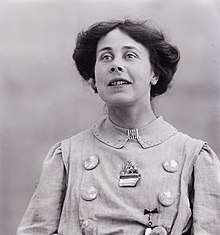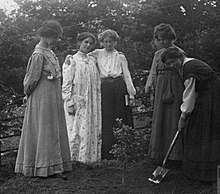Mary Phillips (suffragette)
| Mary Elizabeth Phillips | |
|---|---|
 | |
| Born |
15 July 1880 St Mary Bourne |
| Died |
21 June 1969 (aged 88) Hove, Sussex |
| Nationality | United Kingdom |
| Occupation | Activist |
Mary Elizabeth Phillips (15 July 1880 - 21 June 1969) was a suffragette, feminist and socialist. She was the longest prison serving suffragette. She worked for Christabel Pankhurst but was sacked; she then worked for Sylvia Pankhurst.
Early life
Mary Elizabeth Phillips was born in Hampshire, the daughter of William Fleming Phillips and Louisa Elizabeth (Simms) Phillips. Her father was a doctor who worked in Glasgow.[1]
Suffrage movement
Phillips was encouraged by her father to campaign for women's rights and in 1904 she became a paid official of the Glasgow and West of Scotland Association for Women's Suffrage.[1] She later reported that this taught her that quiet campaigning was not going to be sufficient and she joined the more radical Women's Social & Political Union in 1907 and established a Glasgow branch of the WSPU. She wrote articles for Forward which was the journal of the Glasgow ILP.[2]
In March 1908 she was sentenced to six weeks in Holloway Prison following a demonstration outside the House of Commons. A further arrest in June 1908 resulted in a 3-month sentence making her the longest serving suffragette prisoner.[1] When Phillips was released from prison she was welcomed by Flora Drummond, bagpipes and other suffragettes who posed in tartan for a picture under the slogan "Ye Mauna Tramp on the Scotch Thistle Laddie". The Scottish suffragettes present compared their struggle to the campaign of William Wallace.
.jpg)

Phillips was invited to Mary Blathwayt's home at Batheaston where the leading suffragettes met and recovered. It was known as the "Suffragette's Rest". Significant visitors were asked to plant a tree to record their achievements on behalf of the cause e.g. a prison sentence.[3]
She worked for the WSPU under Christabel Pankhurst where she praised and her salary was increased. In 1913 she was sacked and only record says that "that you are not effective as a district organiser". She immediate began work for Sylvia Pankhurst's rival group working under the same of Mary Pederson..[1]
She died in a hotel in Hove in Sussex.
References
- 1 2 3 4 "Mary Phillips". www.oxforddnb.com. Retrieved 2017-03-08.
- ↑ Sarah Pedersen (3 July 2017). The Scottish Suffragettes and the Press. Palgrave Macmillan UK. pp. 143–. ISBN 978-1-137-53834-5.
- ↑ Simkin, John (September 1997). "Mary Blathwayt". Spartacus Educational. Retrieved 2017-10-24.